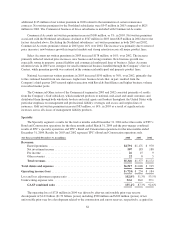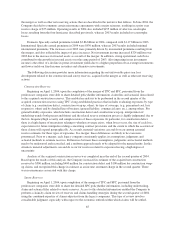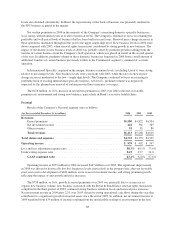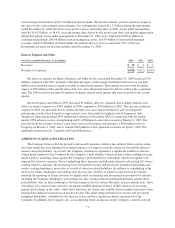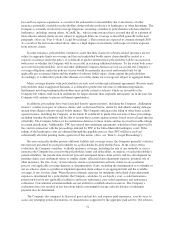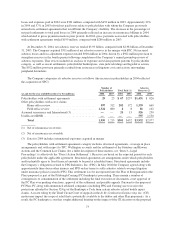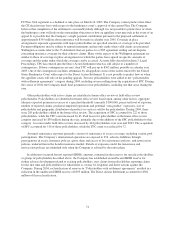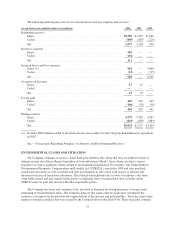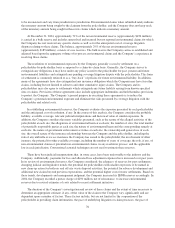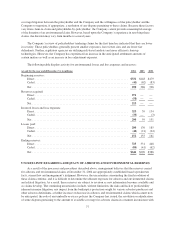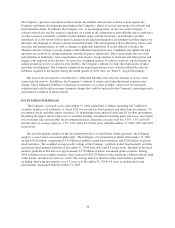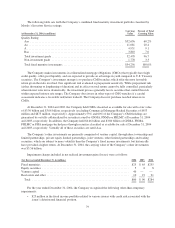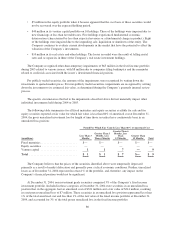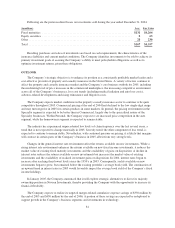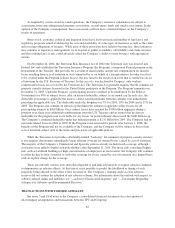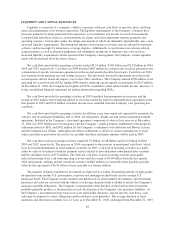Travelers 2004 Annual Report Download - page 86
Download and view the complete annual report
Please find page 86 of the 2004 Travelers annual report below. You can navigate through the pages in the report by either clicking on the pages listed below, or by using the keyword search tool below to find specific information within the annual report.PC Plan. Oral argument is scheduled to take place on March 16, 2005. The Company cannot predict what effect
the CE decision may have with respect to the bankruptcy court’s approval of the current Plan. The Company
believes that completion of the settlement is reasonably likely although it is not possible to predict how or when
the bankruptcy court will rule on the outstanding objections or how an appellate court may rule in the event of an
appeal. It is possible that the Company’s single payment contribution pursuant to the proposed settlement of
approximately $395 million after reinsurance will be made in calendar year 2005. Coverage in place
arrangements represent agreements with major policyholders on specified amounts of coverage to be provided.
Payment obligations may be subject to annual maximums and are only made when valid claims are presented.
Wellington accounts refer to the 35 defendants that are parties to a 1985 agreement settling certain disputes
concerning insurance coverage for their asbestos claims. Many of the aspects of the Wellington agreement are
similar to those of coverage in place arrangements in which the parties have agreed on specific amounts of
coverage and the terms under which the coverage can be accessed. As more fully described in Item 3, Legal
Proceedings, TPC has entered into the Direct Action Settlement which is still subject to a number of
contingencies. If those contingencies are met, then TPC will pay up to $502 million, possibly in calendar year
2005. One of the contingencies includes affirmance by all appellate courts of the orders entered by the United
States Bankruptcy Court with respect to the Direct Action Settlement. It is not possible to predict how or when
the appellate courts will rule on the pending appeals. Ten new policyholders were added to the “policyholders
with settlement agreements” category during 2004, including seven resulting from the acquisition of SPC. During
the course of 2004, the Company made final payments to four policyholders, including one that arose during the
year.
Other policyholders with active claims are identified as home office review or field office review
policyholders. Policyholders are identified for home office review based upon, among other factors: aggregate
ultimate expected payments in excess of a specified threshold (currently $100,000), perceived level of exposure,
number of reported claims, products/completed operations and potential “non-product” exposures, size of
policyholder and geographic distribution of products or services sold by the policyholder. During 2004, there
were 285 policyholders added to the home office review. The acquisition of SPC accounted for 222 of those
policyholders, while the TPC count increased by 63. Paid losses for policyholders in the home office review
category increased by $30 million during the year, primarily due to the addition of the SPC policyholders to this
category. Accounts under field office review increased by 444 policyholders over year-end 2003. The acquisition
of SPC accounted for 516 of those policyholders, while the TPC count was reduced by 72.
Assumed reinsurance exposure primarily consists of reinsurance of excess coverage, including various pool
participations. The Company’s international operations are exposed to U.S. asbestos liabilities through
participations in excess insurance policies, quota share and excess of loss reinsurance policies, and retrocession
policies, underwritten in the London insurance market. Details of exposures under the reinsurance and
retrocession policies are identified only when the Company is advised by the retrocedant.
In addition to incurred but not reported (IBNR), amounts contained in the reserves for specific policyholders
or groups of policyholders described above, the Company has established an unallocated IBNR reserve for
further adverse development related to existing policyholders, new claims from policyholders reporting claims
for the first time and policyholders for which there is, or may be, litigation and direct actions against the
Company. During 2004, reclassification of reserves to “Policyholders with settlement agreements” resulted in a
reduction in the unallocated IBNR reserve of $595 million. The Direct Action Settlement accounted for $502
million of this reclassification.
74


